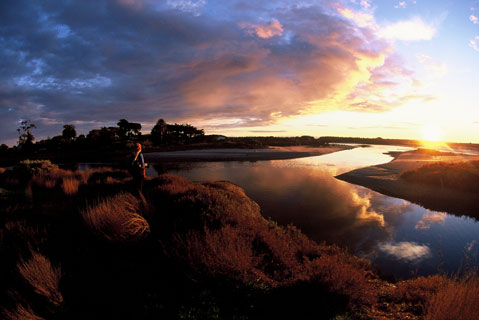Growing Up on the Carpinteria Salt Marsh
Profiles in UCSB’s Natural Reserve System

With the tide creeping in, the serpentine channels of the Carpinteria Salt Marsh Reserve came to life. Several four-foot-long leopard sharks darted back and forth in the crystal clear shallows, barely skimming over the cobble. Stingrays flapped their wings across the channel bottom before scooching beneath the mud, and schools of glistening corbina swam along the steep embankments.
This is where I learned to watch and wait for those natural wonders to unfold before me. The Carpinteria Salt Marsh was my home from 1975-1999. As an unencumbered kid fortunate enough to live on the beach, I grew up among the various shades of pickleweed, lurking leopard sharks, and opportunistic ospreys. For years, my early-morning avian alarm clock was the perpetual rattle of the belted kingfisher hovering over a nearby channel beneath my window.
The 230-acre salt marsh reserve attracts multi-campus, multi-agency research groups funded by the United States Environmental Protection Agency, National Science Foundation, and the National Institute of Health. They’ve looked at historical tsunami activity, the frequency of floods, the spread of infectious diseases in mud snails, and what good parasites thrive in the marsh. Its mouth a nursery for halibut and other fish species, the marsh also filters out excessive nutrients from neighborhoods and agricultural runoff before reaching the ocean.
“From Point Conception to San Diego, it’s one of the healthier marshes in Southern California,” explained reserve manager Andrew Brooks. “It’s now serving as a reference and study site for all aspects affecting watersheds, offshore kelp beds, and anything else surrounding the marsh.”
For the casual observer, the results of these studies aren’t visible, but the diversity of birdlife is evident, a strong indicator of how well the marsh is functioning. Once slated to be a harbor, the reserve harbors 200 documented bird species.
One of my favorites is the overly skittish white-tailed kite. They furiously hover above the marsh like no other raptor can as they search for food in the pickleweed. Its almond-shaped red eyes stand out against its creamy white, gray, and black feathers.
“Traditionally we’d go in and count plant and bird species to determine the health of the marsh,” explained Brooks. “Now we use these types of measures instead to tell how well the marsh is functioning.”



